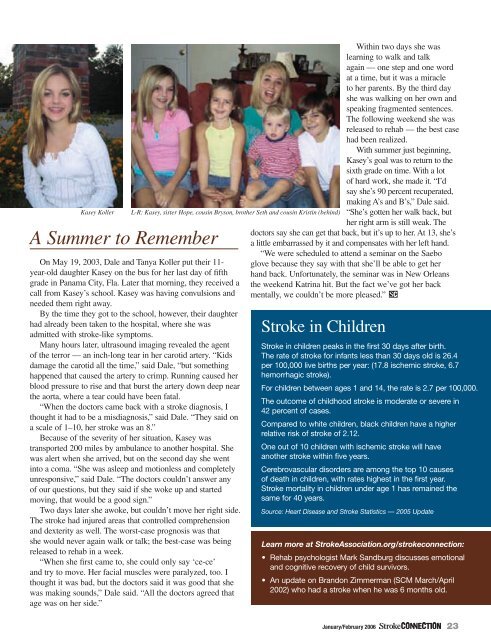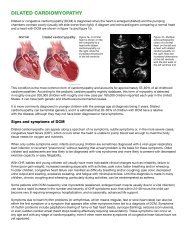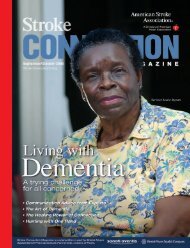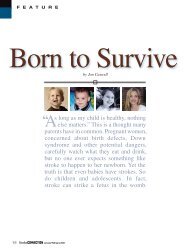Born to Survive - American Stroke Association
Born to Survive - American Stroke Association
Born to Survive - American Stroke Association
Create successful ePaper yourself
Turn your PDF publications into a flip-book with our unique Google optimized e-Paper software.
Kasey Koller<br />
A Summer <strong>to</strong> Remember<br />
L-R: Kasey, sister Hope, cousin Bryson, brother Seth and cousin Kristin (behind)<br />
On May 19, 2003, Dale and Tanya Koller put their 11year-old<br />
daughter Kasey on the bus for her last day of fifth<br />
grade in Panama City, Fla. Later that morning, they received a<br />
call from Kasey’s school. Kasey was having convulsions and<br />
needed them right away.<br />
By the time they got <strong>to</strong> the school, however, their daughter<br />
had already been taken <strong>to</strong> the hospital, where she was<br />
admitted with stroke-like symp<strong>to</strong>ms.<br />
Many hours later, ultrasound imaging revealed the agent<br />
of the terror — an inch-long tear in her carotid artery. “Kids<br />
damage the carotid all the time,” said Dale, “but something<br />
happened that caused the artery <strong>to</strong> crimp. Running caused her<br />
blood pressure <strong>to</strong> rise and that burst the artery down deep near<br />
the aorta, where a tear could have been fatal.<br />
“When the doc<strong>to</strong>rs came back with a stroke diagnosis, I<br />
thought it had <strong>to</strong> be a misdiagnosis,” said Dale. “They said on<br />
a scale of 1–10, her stroke was an 8.”<br />
Because of the severity of her situation, Kasey was<br />
transported 200 miles by ambulance <strong>to</strong> another hospital. She<br />
was alert when she arrived, but on the second day she went<br />
in<strong>to</strong> a coma. “She was asleep and motionless and completely<br />
unresponsive,” said Dale. “The doc<strong>to</strong>rs couldn’t answer any<br />
of our questions, but they said if she woke up and started<br />
moving, that would be a good sign.”<br />
Two days later she awoke, but couldn’t move her right side.<br />
The stroke had injured areas that controlled comprehension<br />
and dexterity as well. The worst-case prognosis was that<br />
she would never again walk or talk; the best-case was being<br />
released <strong>to</strong> rehab in a week.<br />
“When she first came <strong>to</strong>, she could only say ‘ce-ce’<br />
and try <strong>to</strong> move. Her facial muscles were paralyzed, <strong>to</strong>o. I<br />
thought it was bad, but the doc<strong>to</strong>rs said it was good that she<br />
was making sounds,” Dale said. “All the doc<strong>to</strong>rs agreed that<br />
age was on her side.”<br />
Within two days she was<br />
learning <strong>to</strong> walk and talk<br />
again — one step and one word<br />
at a time, but it was a miracle<br />
<strong>to</strong> her parents. By the third day<br />
she was walking on her own and<br />
speaking fragmented sentences.<br />
The following weekend she was<br />
released <strong>to</strong> rehab — the best case<br />
had been realized.<br />
With summer just beginning,<br />
Kasey’s goal was <strong>to</strong> return <strong>to</strong> the<br />
sixth grade on time. With a lot<br />
of hard work, she made it. “I’d<br />
say she’s 90 percent recuperated,<br />
making A’s and B’s,” Dale said.<br />
“She’s gotten her walk back, but<br />
her right arm is still weak. The<br />
doc<strong>to</strong>rs say she can get that back, but it’s up <strong>to</strong> her. At 13, she’s<br />
a little embarrassed by it and compensates with her left hand.<br />
“We were scheduled <strong>to</strong> attend a seminar on the Saebo<br />
glove because they say with that she’ll be able <strong>to</strong> get her<br />
hand back. Unfortunately, the seminar was in New Orleans<br />
the weekend Katrina hit. But the fact we’ve got her back<br />
mentally, we couldn’t be more pleased.”<br />
<strong>Stroke</strong> in Children<br />
<strong>Stroke</strong> in children peaks in the first 30 days after birth.<br />
The rate of stroke for infants less than 30 days old is 26.4<br />
per 100,000 live births per year: (17.8 ischemic stroke, 6.7<br />
hemorrhagic stroke).<br />
For children between ages 1 and 14, the rate is 2.7 per 100,000.<br />
The outcome of childhood stroke is moderate or severe in<br />
42 percent of cases.<br />
Compared <strong>to</strong> white children, black children have a higher<br />
relative risk of stroke of 2.12.<br />
One out of 10 children with ischemic stroke will have<br />
another stroke within five years.<br />
Cerebrovascular disorders are among the <strong>to</strong>p 10 causes<br />
of death in children, with rates highest in the first year.<br />
<strong>Stroke</strong> mortality in children under age 1 has remained the<br />
same for 40 years.<br />
Source: Heart Disease and <strong>Stroke</strong> Statistics — 2005 Update<br />
Learn more at <strong>Stroke</strong><strong>Association</strong>.org/strokeconnection:<br />
• Rehab psychologist Mark Sandburg discusses emotional<br />
and cognitive recovery of child survivors.<br />
• An update on Brandon Zimmerman (SCM March/April<br />
2002) who had a stroke when he was 6 months old.<br />
January/February 2006







